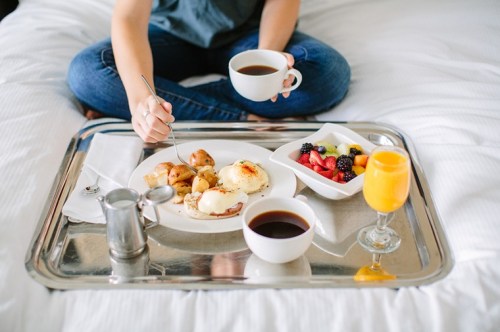Our editors independently select these products. Making a purchase through our links may earn Well+Good a commission
Let’s be honest: “organizational expert” isn’t the sexiest job title, so it’s kind of surreal that Marie Kondo has amassed a following as loyal as the Beyhive. And it’s all about the decluttering master‘s simple approach, centered on the question: Does it spark joy?
By now, you’ve been able to apply this Kondo logic to the clothes in your closet (not to mention every room in your house), as well as your love life and even your mind. But there’s one final frontier left: diet.
What would happen if you only ate food that sparked joy? Would it result in meals consisting of mac and cheese, cupcakes, and ice cream? Or would your body naturally crave nutrient-dense food?
I decided to find out, eating only what gave me joy—tough job, but someone’s gotta do it—for two weeks. It may not sound revolutionary, but in a culture racked with food guilt (which favors noshing while multitasking and chowing down on whatever is most convenient), mindfully eating and savoring every meal doesn’t happen as much as it should.
The ground rules
Serendipitously, a new book just came out based on the idea of eating whatever you want—and not feeling guilty about it. The Naughty Diet is a sexed-up lifestyle plan, based on choosing foods that give you pleasure (and dropping a few pounds, if you’re into that).
How do these two things co-exist? Author and integrative nutrition health coach Melissa Milne asks readers to “set the table for pleasure,” eating with their eyes first by dining at a nicely laid-out table setting (no chowing down on salad over your keyboard at work), chewing “slower, deeper, and longer,” and “indulging passionately”—all without counting calories.
I used to her rules, combined with Kondo’s brilliant take on life (er, living rooms), to create my own two-week plan. Before each bite I asked: Does this give me joy?
Here’s what I learned from Marie Kondo-ing my diet.

Your body knows what you need
Even though I had a free pass to eat as many pancakes and burgers as I wanted, it’s not what I found myself drawn to. I still craved the foods I normally ate (eggs, veggie and brown rice stir-fry, chicken and avocado tacos), which makes sense considering that science says you actually desire what you regularly eat.
But one night, I got a serious craving for peanut butter cups—something I haven’t had in years. So I got them. I savored every single bite, and it really did bring me a lot of joy. But when I found myself daydreaming of another one a few days later and I followed the urge, I didn’t get the same high. The takeaway: indulging in treats all the time takes away from the specialness of it.
Interestingly, I didn’t end up eating more often than I regularly do or overeating at meals, something I expected would happen. The Naughty Diet says your body knows what’s good for you—you just have to listen to it.
“There’s a brain in the digestive tract that holds the answers to meal timing and portion control called the enteric nervous system (ENS),” Milne writes. “Get acquainted with your ENS, and every meal’s like wining and dining with your own personal nutritionist. You’ll know what and how much to eat, and exactly when you can afford to indulge again.”

Meals without multitasking take work
Eating is never my sole activity. At the office, I eat and work simultaneously, at home I have my meals in front of the TV (or a fork in one hand and a book in the other), and when I dine out with friends, I’m more focused on the conversation than what’s on my plate. So just eating was, well, an adjustment.
Here’s the thing: it didn’t give me joy. After savoring the first few bites, I got bored every time. Milne’s book points out—and science proves her right—that when you eat without doing something else, you enjoy your food more and eat less. For me, I did eat less when I ate undistracted, but I certainly didn’t enjoy my food more.

Sparking joy can get expensive
I usually spend Sunday nights meal prepping for the week, filling the fridge with salads to take with me to work. I still made my green bowls, but when lunchtime rolled around each day, I wanted a better salad. What sparked joy around 1 p.m. for me was an $8 bowl, not the one I made and was already bored with.
After a few days, I learned that the feeling of spending more money than I wanted on my meals overshadowed the joy I felt while eating, so I reined in my spending and focused more on creating homemade salads using ingredients I love (for me, that would include baby spinach, chicken, walnuts, and lots of avocado slices).

The big takeaway
So, was eating only foods that sparked joy life-changing? Not really. For better or for worse, I already eat what I want most of the time. And now that I’ve officially resumed mealtimes in front of the TV (hey, the new seasons of Orange is the New Black isn’t going to watch itself), I’m happier.
But I have to say: There’s something to the whole “setting the table for pleasure” idea. I mean, if nothing else, it just makes for a better Instagram. Which, incidentally, could spark joy in its own, science-backed way.
Happiness and what you eat are definitely linked—science says so. And whether you eat lunch at your desk or not, you’ll want to tidy it up: It turns out, a cluttered workspace is bad for your brain.
Sign Up for Our Daily Newsletter
Get all the latest in wellness, trends, food, fitness, beauty, and more delivered right to your inbox.
Got it, you've been added to our email list.











